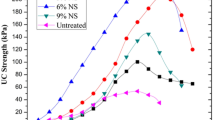Abstract
Clayey subgrade soil requires treatment in order to make the subgrade stable for pavement structures. Treatment of clayey soil i.e. stabilization of clayey soil by cement, lime, and fly ash are established techniques used in geotechnical and highway engineering. Stabilization by alkali activation of fly ash is reported recently but literatures are limited. Present study investigates the stress strain behavior, peak stress and ultimate strain of clayey soil stabilized by slag and slag-fly ash blending by alkali activation. The peak stress as high as 25.0 N/mm2 may be obtained at 50% slags content when 12 molar sodium hydroxide solutions were used. Peak stress, ultimate strain and slope of stress–strain curve of stabilized clay are controlled by Na/Al and Si/Al ratios. Stress–strain response and peak stress of slag and fly ash blended specimen are not governed by Na/Al and Si/Al ratios; rather the behavior is dependent predominantly on slag content.















Similar content being viewed by others
References
Andini S, Cioffi R, Colangelo F, Grieco T, Montagnam D, Santoro L (2008) Coal fly ash as raw material for the manufacturing of geopolymer based product. Waste Manag 28:416–423
ASTM C39/C39M-05 (2005) Standard test method for compressive strength of cylindrical concrete specimens. American Society for Testing and Maretials, US
Baker S (2000) Deformation behavior of lime-cement column stabilized clay, Ph. D. thesis, Chalmers University of Technology, Sweden
Bakharev T (2005a) Durability of geopolymer material in sodium and magnesium sulfate solutions. Cem Concr Res 35:1233–1246
Bakharev T (2005b) Resistance of geopolymer materials to acid attack. Cem Concr Res 35:658–670
Bascarevic Z, Komljenovic M, Miladinovic Z, Nikllic V, Marjanovic N, Zujovic Z (2013) Effect of concentrated NH4NO2 solution on mechanical properties and structure of the fly ash based geopolymers. Constr Build Mater 41:570–579
Bergardo DT, Anderson LR, Miura N, Balasubramaniam AS (1996) Soft ground improvement in low land and other environment. ASCE Press, New York, pp 234–304
Chew SH, Kamruzzaman AHM, Lee FH (2004) Physicochemical and Engineering behavior of cement treated clays. J Geotech Geoenviron 130:696–706
Cordon WA (1962) Resistance of soil cement exposed to sulfates. 40th Annual Meeting of the Highway Research Board, Highway Research Board Bulletin, 309, Washington, DC
Cristelo N, Glendinning S, Farnandes L, Pinto AT (2011) Effect of calcium content on soil stabilization with alkaline activation. Constr Build Mater 29:167–174
Cristelo N, Glendinning S, Pinto AT (2012) Deep soft soil improvement by alkaline activation. Ground Improv 164:1–9
Du Y, Yu B, Liu K, Jiang N, Liu MD (2016) Physical, hydraulic, and mechanical properties of clayey soil stabilized by lightweight alkali-activated slag geopolymer. J Mater Civ Eng. doi:10.1061/(ASCE)MT.1943-5533.0001743
Duxson P, Fernandez-Jimenez A, Provis JL, Palomo A, van Deventer JSJ (2007) Geopolymer technology, the current state of the art. J Mater Sci 42:2917–2933
EL-Sayed HA, ABO EL-Enein SA, Khater HM, Hasanein SA (2011) Resistance of alkali activated water cooled slag geopolymer to sulphate attack. Ceram Silik 55:153–160
Fernandez-Bertran JF (1999) Mechanochemistry: an overview. Pure Appl Chem 71:581–586
Guo X, Xiang D, Duan G, Mou P (2010) A review of mechanochemisty application in waste management. Waste Manag 30:4–10
Hua Jian L, Sun Heng Hu, Xu Chu TIE, Xiao Xue Jun (2008) A new method to evaluate the hydraulic activity of Al–Si materials. Sci China Ser E 51:113–120
IS: 2720, Part-1 (1995) Preparation of dry soil samples. Bureau of Indian Standard, New Delhi
IS: 4031, Part 5 (1988) Methods of physical tests for hydraulic cement. Bureau of Indian Standard, New Delhi
IS: 8112 (1989) Specification for 43 grade ordinary portland cement. Bureau of Indian Standard, New Delhi
Juenger MCG, Winnefld F, Provis JL, Ideker JK (2011) Advances in alternative cementitious binders. Cem Concr Res 41:1232–1243
Kawasaki T, Niina A, Saitoh S, Suzuki Y, Honjo Y (1981) Deep mixing method using cement hardening agent. In: Proceedings of the 10th international conference on soil mechanics and foundation engineering, Southeast Asian Geotechnical Society, Bangkok, 721–724
Kehew EA (1995) Geology for engineers and environmental scientists, 2nd edn. Prentice Hall, Englewood Cliff, pp 295–302
Khale D, Chaudhary R (2007) Mechanism of geopolymerisation and factors influencing its development: a review. J Mater Sci 42:729–746
Khater HM (2013) Studying the effect of thermal and acid exposure on alkali-activated slag geopolymer. Adv Cem Res 25:1–9
Lee WKW, van Deventer JSJ (2002) Structural reorganisation of class F fly ash in alkaline silicate solutions. Colloid Surf A 211:49–66
Little DN (1995) Handbook for stabilization of pavement sub-grades and base courses with lime. Kendall Hunt Publishing, Dubuque
Marjanovic N, Komlijenovic M, Bascarvic Z, Nikolic V (2014) Improving reactivity of fly ash and properties of ensuing geopolymer through mechanical activation. Constr Build Mater 57:151–162
Mitchell JK (1986) Practical problems from surprising soil behavior. J Geotech Eng-ASCE 112:259–289
Neville AM (2011) Properties of concrete. Pearson Education Limited, Edinburgh Gate, Essex
Nicholson CL, Fletcher RA (2005) Geopolymers and methods for their production. Patent No. WO 2005/019130 A1
Palmer JT, Edgar TV, Boresi AP (1995) Strength and density modification of unpaved road soils due to chemical additives, MPC Report No. 95–39, Mountain–Plains Consortium, Fargo, ND
Palomo A, Grutzeck MW, Blanco MT (1999) Alkali-activated fly ashes: a cement for the future. Cem Concr Res 29:1323–1329
Panias D, Giannopoulou IP, Perraki T (2007) Effect of synthesis parameter on the mechanical properties of fly ash based geopolymer. Colloid Surface A 301:246–254
Portland Cement Association (1992) Soil cement laboratory handbook. Portland Cement Association, Skokie, Illinois
Probaha A, Shibuya S, Kishida T (2000) State of the art in deep mixing technology Part III, geomaterial characterization. Ground Improv 3:91–100
Provis JL, van Deventer JSJ (2013) Alkali activated materials: state-of-the-art report, RILEM TC 224-AAM. Springer, Berlin
Rees CA (2007) Mechanism and kinetics of gel formation in geopolymers. Ph. D. thesis, The University of Melbourne, Australia
Sherwood PT (1993) Soil stabilization with cement and lime: state of the art review. HMSO Publication, London
Van Ganse RF (1973) Immediate stabilisation of wet soils. In: Proceedings of the 8th international conference on soil mechanics and foundation engineering, Part 2, 233–237
van Jaarsveld JGS, van Deventer JSJ (1999) Effect of the alkali metal activator on the properties of fly ash based geopolymer. Ind Eng Chem Res 38:3932–3941
van Jaarsveld JGS, van Deventer JSJ, Lorenzen L (1998) Factors affecting the immobilisation of metals in geopolymerized fly ash. Metall Mater Trans B 29:283–291
Veith GH (2000) Engineering properties of sulfate bearing clay soil stabilized with lime activated GGBS, Ph. D. thesis, University of Glamorgan
Verdolotti L, Iannance S, Lavorgna M, Lumanaa R (2008) Geopolymerization reaction to consolidate incoherent pozzolanic soil. J Mater Sci 43:865–873
Weng X, Wang W (2011) Influence of differential settlement on pavement structure of widened roads based on large-scale model test. J Rock Mech Geotech Eng 3:90–96
Wild S, Kinuthia JM, Robinson RB, Humphires I (1996) Effect of GGBS on strength and swelling properties of lime stabilized kaolinite in presence of sulfates. Clay Miner 31:423–433
Xu H, van Deventer JSJ (2003) Effect of source materials on geopolymerization. Ind Eng Chem Res 42:1698–1706
Mehrotra SP, Kumar S, Bandopadhyay A, Kumar R (2008) An improved process for the production of geopolymeric material from fly ash. Australian Patent No. AU 2007200076 A1
Yaolin Y, Cheng L, Songyu L (2015) Alkali-activated ground-granulated blast furnace slag for stabilization of marine soft clay. J Mater Civ Eng 27:04014146
Zhang YS (2003) Research on structure formation mechanism and properties of high-performance geopolymer concrete. Ph. D. thesis, Southeast University, Nanjing, China
Zhang Q, Saito F (2012) A review on mechanically synthesis of functional materials. Adv Powder Technol 23:523–531
Zhang Z, Tao M (2008) Durability of Cement Stabilized Low Plasticity Soils. J Geotech Geoenviron 134:203–213
Zhang M, Guo H, El-Korchi T, Zhang G, Tao M (2013) Experimental feasibility study of geopolymer as the next-generation soil stabilizer. Constr Build Mater 47:1468–1478
Zivanovic B, Sreckovic T, Komlfemovic M (2002) The influence of mechanical activation on the process of reaction sintering of Portland cement clinker. Sci Sinter 34:95–100
Author information
Authors and Affiliations
Corresponding author
Rights and permissions
About this article
Cite this article
Singhi, B., Laskar, A.I. & Ahmed, M.A. Mechanical Behavior and Sulfate Resistance of Alkali Activated Stabilized Clayey Soil. Geotech Geol Eng 35, 1907–1920 (2017). https://doi.org/10.1007/s10706-017-0216-x
Received:
Accepted:
Published:
Issue Date:
DOI: https://doi.org/10.1007/s10706-017-0216-x




